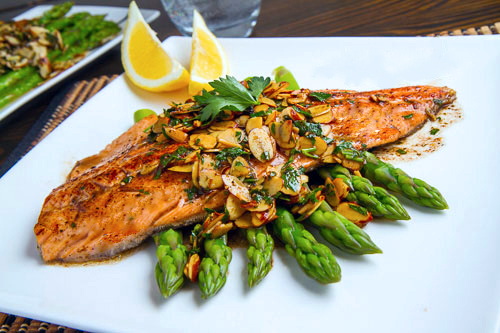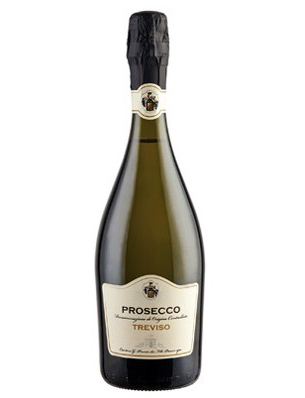Agriculture has been important to the province of Varese since the time of the Roman Empire and a wide range of local produce is grown, particularly asparagus and eggplant. Local cheeses are most often made from goat’s milk, such as Formaggella, a semi-hard mild cheese. In the mountains, the famous Val Veddasca is shaped like a violin. Three types of honey are produced here as well, millefiori (thousand flowers), acacia honey and chestnut honey, often enjoyed as an accompaniment to goat cheese. With the number of large lakes and rivers, it comes as no surprise that freshwater fish is hugely popular, especially trout from the rivers and perch from the lakes. Frogs legs and crayfish are also used to add additional character to fish dishes and especially in risotto.
Most people are familiar with Amaretto. Very few realize where it originated, even though the most popular brand’s name gives it away – Disaronno, which is actually di Saronno, literally of Saronno, a town in the province of Varese. Amaretto means “a little bitter.” It is actually a sweet liqueur, but it was originally flavored with bitter almonds and apricots.
The legend of the origin of the liquor Amaretto is traced to the year 1525. A church in Saronno commissioned artist Bernardino Luini, one of Leonardo da Vinci’s pupils, to paint its sanctuary with frescoes. As the church was dedicated to the Virgin Mary, Luini needed to depict the Madonna, but was in need of a model. He found his inspiration in a young widowed innkeeper. Out of gratitude and affection, the woman wished to give him a gift. Her simple means did not permit much, so she steeped apricot kernels in brandy and presented the resulting concoction to the artist, thus Amaretto was created.
Amaretto is frequently added to desserts, including ice cream, which enhances the flavor of the dessert with almonds and is also used as a complementary to the flavor of chocolate. A variant of Tiramisu is flavored with Amaretto. It can be added to pancake batter for a richer texture and it is often added to almandine sauce for fish and vegetables. When served as a beverage, it can be drunk by itself, used as an ingredient to create several popular mixed drinks or added to coffee.
Varese Trout Almandine
The rivers in Varese are filled with delicious trout. This dish combines the flavorful fish with locally produced Amaretto to produce a delicious almandine sauce.
Ingredients
- ½ cup flour
- 1 cup milk
- ½ tsp salt
- 1/4 tsp black pepper
- 4 trout fillets
- 1 tbsp olive oil
- 3 tbsp butter
- 2 garlic cloves, smashed and peeled
- ½ cup sliced almonds
- 1 oz Amaretto
- 1 tbsp fresh lemon juice
Preparation
Place the flour, salt and pepper in a shallow dish and pour the milk in a separate bowl. Place the trout fillets in the milk. Heat a large sauté pan over medium flame. Add the olive oil and 2 tablespoons of butter. Dredge the fillets in the flour mixture on both sides. Add to the pan and increase heat to medium high. Put the garlic cloves in the pan and swirl it around.
Turn the trout after 2 minutes and remove the garlic (you don’t want it to brown). Sauté until the fish is cooked through and lightly golden brown, about 1 or 2 more minutes. Remove from pan and cover to keep warm.
Return the sauté pan to the heat and add the remaining tablespoon of butter, the Amaretto and the almonds. Cook for one minute and add the fresh lemon juice. Heat for one additional minute and then spoon over the trout fillets. Serve over asparagus with additional lemon wedges
Risotto alla Certosina
Risotto is more popular than pasta in the northern portions of Lombardia and the name of this dish translates to ‘Painstaking Rice.’ This recipe substitutes shrimp for crayfish, but the frogs legs are a must in this delicious dish!
Ingredients
- 12 oz rice
- 12 oz shrimp, cleaned
- 12 frogs legs
- 3 oz peas
- 5 oz mushrooms, sliced
- 3 tbsp olive oil
- 3 perch fillets (12 oz)
- ½ dry white wine
- 2 garlic cloves, sliced
- ½ fennel bulb, sliced
- 1 celery stalk, chopped
- 1 small onion, chopped
- 3 tbsp butter
- salt and pepper
Preparation
Clean the perch, removing any bones, but leaving the skin on. Devein the shrimp and remove from the shells. Clean and slice the fennel and mushrooms. Slice the garlic. Clean the other vegetables and finely chop. In a large sauté pan, heat 2 tablespoons of olive oil over a medium flame. Sauté the garlic, fennel, onion and celery with a pinch of salt. Once softened, add the rice and stir until lightly toasted, about 3 minutes. Pour in the white wine and simmer until evaporated, then add a cup of water and cook until absorbed. Continue adding water ½ cup at a time, until the rice is al dente. Stir in the peas and shrimp. Season to taste with salt and pepper. Add 1 tablespoon of butter, stir then cover and leave to rest.
Meanwhile, melt the remaining butter in a non-stick frying pan with a splash of olive oil. Season the frogs legs and add to the pan. Cook until nicely browned and cooked through, basting with the foaming butter, then set aside and keep warm. Season the perch with a bit of salt and pepper and add to the pan, cooking skin-side down for about 4 minutes or until the skin is crispy and golden. Flip the fish over and take the pan off the heat and allow to sit for 2 minutes. Slice each fillet into three or four pieces. Divide the warm risotto into 4 bowls. Top with frogs legs and slices of perch and enjoy!





